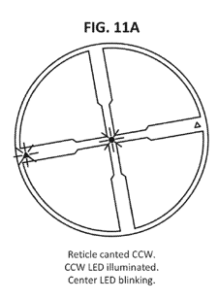
Sig Sauer was recently granted US Patent 11,402,175 (“Patent ‘175”) which is titled OPTICAL SYSTEM WITH CANT INDICATION and was prosecuted by fellow Oregon attorneys at Miller Nash. This Sig Sauer patent demonstrates that in the firearm and related accessory arts, what may at first appear to be merely an incremental system improvement can ultimately provide a path toward patent protection when claimed in context with other components in the system.

US Patent 11,402,175 is directed to a telescopic sight which provides an indication of an angle of cant relative to an optical axis of the sight. Figure 11A of the patent provides an example of a canted firearm sight and the indication provided by the telescopic sight.
A potential inventor or intellectual property department might question whether a telescopic sight that indicates cant is patentable. An argument could be made that the USPTO would likely reject a telescopic sight that indicates cant as obvious in view of a combination of a firearm sight and a level, as just an example.
However, by using a strategic approach that integrates the improved sight into the firearm context with additional features that provide synergy, it is possible to provide valuable protection in the marketplace. For example, the claims of Patent ‘175 recite “an electronic indicator […] structured to provide an indicator signal to a user related to the relative amount of cant” in combination with lights having different intensities or flashing at different speeds to indicate the amount of cant and the indicator [of cant] located proximate the rear focal plane of the telescopic sighting device.
The integration of a general concept into a specific application can be a method to obtain protection for new features in the marketplace if your patent counsel is well-versed in the technical field. It can also be difficult to predict which specific combination of features will be successful at the patent office, which is why it can be important to have a full disclosure of the implementation of new features in the system. A thorough disclosure including various combinations allows for adaptability of the claims in response to changing circumstances. In this way, specific details of an embodiment (such as the location of an indicator) may not seem crucial to patentability when initially considering a patent application but can often be decisive in overcoming prior art.
At McCoy Russell, we use our expertise in firearms and patent law to help our clients determine patentability of inventions and prepare high quality patent applications that protect their intellectual property. Please contact us if we can be of help to you.

